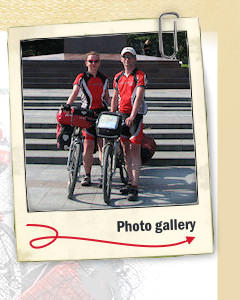Budapest
The traffic wakes us up in the morning. Fortunately, the sun is shining. We eat salami sandwiches for breakfast. I have no motivation for cycling today and that makes me angry. However, kilometres somehow pass by. In towns and villages, we use cycle lanes, though not always, because sometimes they are too bumpy. In Nagykata, road no. 31 leads us outside the town, to a bypass on which bikes are disallowed. Damn it! If we had known that, we would have cycled through the centre, and now the only thing we can do is to break the ban again. Luckily we avoid close encounters with the police.
A dozen or so kilometres from Budapest, we enter upland areas. Fortunately, the climbs are short, but they still present a challenge to my knees, which today are in pain as never before. In the end we get a reward: a few kilometres of a downhill road all the way to Vecses. It is a typical tourist town with a lot of small hotels and guesthouses, which serve as a starting point for excursions to Budapest. In the evening, Igor dismantles the bikes while I pack up the rest of the luggage. On the next day we just want to visit Budapest and at 8 pm we have to be at the airport.
Budapest is called the Pearl of the Danube, and not without reason – it is one of the most beautiful European capitals. It became a single city in 1872, after two cities - Buda and Pest - were officially merged. Buda is located higher, on the right bank of the Danube. It is characterized by elevated, steep streets. Pest is located on the left, flat bank. Both parts of the city are connected by 6 bridges. Budapest is a green city, renowned for its numerous spas and hot springs. There are several interesting landmarks. As for architectural monuments, I was most impressed with the Parliament building. The neo-Gothic edifice is 268 metres long and its main facade, decorated with spires and 88 statues of Hungarian rulers, dominates the surroundings. The Castle Hill (Várhegy) is the most spectacular place in Buda. We got there with the renovated, 19th century cable car, which runs from Clark Ádám tér, just by the Chain Bridge (a single two-way ticket costs HUF 1400). The walk among old buildings, narrow streets and courtyards is unforgettable. We admire the magnificent Matthias fountain, along with a magnificent view of the river, bridges and the lower part of Budapest. The afternoon passes quickly. This beautiful city might be explored for a few days, and each day one can discover something new. Unfortunately, we have to go back to pick up our luggage. The taxi called by the owner of our hotel arrives very quickly. At the airport, we are spending our last Hungarian forints buying some alcohol and, of course, salami. We are boarding the plane a bit disappointed: is that it? The end of holidays? The 6 weeks flew by so fast? We were expecting so many adventures - everyone was shocked to hear that we would go to Ukraine and Romania. Eventually, nothing bad happened to us, nothing broke down, we were not assaulted, beaten up, robbed, raped... One could say it was rather boring ;-)
A dozen or so kilometres from Budapest, we enter upland areas. Fortunately, the climbs are short, but they still present a challenge to my knees, which today are in pain as never before. In the end we get a reward: a few kilometres of a downhill road all the way to Vecses. It is a typical tourist town with a lot of small hotels and guesthouses, which serve as a starting point for excursions to Budapest. In the evening, Igor dismantles the bikes while I pack up the rest of the luggage. On the next day we just want to visit Budapest and at 8 pm we have to be at the airport.
Budapest is called the Pearl of the Danube, and not without reason – it is one of the most beautiful European capitals. It became a single city in 1872, after two cities - Buda and Pest - were officially merged. Buda is located higher, on the right bank of the Danube. It is characterized by elevated, steep streets. Pest is located on the left, flat bank. Both parts of the city are connected by 6 bridges. Budapest is a green city, renowned for its numerous spas and hot springs. There are several interesting landmarks. As for architectural monuments, I was most impressed with the Parliament building. The neo-Gothic edifice is 268 metres long and its main facade, decorated with spires and 88 statues of Hungarian rulers, dominates the surroundings. The Castle Hill (Várhegy) is the most spectacular place in Buda. We got there with the renovated, 19th century cable car, which runs from Clark Ádám tér, just by the Chain Bridge (a single two-way ticket costs HUF 1400). The walk among old buildings, narrow streets and courtyards is unforgettable. We admire the magnificent Matthias fountain, along with a magnificent view of the river, bridges and the lower part of Budapest. The afternoon passes quickly. This beautiful city might be explored for a few days, and each day one can discover something new. Unfortunately, we have to go back to pick up our luggage. The taxi called by the owner of our hotel arrives very quickly. At the airport, we are spending our last Hungarian forints buying some alcohol and, of course, salami. We are boarding the plane a bit disappointed: is that it? The end of holidays? The 6 weeks flew by so fast? We were expecting so many adventures - everyone was shocked to hear that we would go to Ukraine and Romania. Eventually, nothing bad happened to us, nothing broke down, we were not assaulted, beaten up, robbed, raped... One could say it was rather boring ;-)




